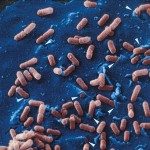Lien vers Pubmed [PMID] – 12154067
J. Cell. Sci. 2002 Sep;115(Pt 17):3357-67
Molecules from some pathogenic bacteria mimic natural host cell ligands and trigger engulfment of the bacterium after specifically interacting with cell-surface receptors. The leucine-rich repeat (LRR)-containing protein InlB of Listeria monocytogenes is one such molecule. It triggers bacterial entry by interacting with the hepatocyte growth factor receptor (HGF-R or Met) and two other cellular components: gC1q-R and proteoglycans. Recent studies point to significant similarities between the molecular mechanisms underlying InlB-mediated entry into cells and classic phagocytosis. In addition, InlB, in common with HGF, activates signaling cascades that are not involved in bacterial entry. Therefore, studies of InlB may help us to analyze the previously noticed similarities between growth factor receptor activation and phagocytosis.

